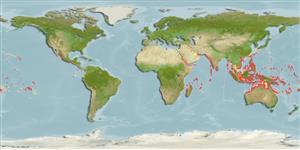Preferred temperature (Referencia
123201): 25.8 - 29, mean 28 °C (based on 744 cells).
Phylogenetic diversity index (Referencia
82804): PD
50 = 0.5000 [Uniqueness, from 0.5 = low to 2.0 = high].
Bayesian length-weight: a=0.01259 (0.00571 - 0.02773), b=3.03 (2.84 - 3.22), in cm total length, based on LWR estimates for this (Sub)family-body shape (Ref.
93245).
Nivel trófico (Referencia
69278): 3.4 ±0.45 se; based on food items.
Resiliencia (Referencia
120179): Alto, población duplicada en un tiempo mínimo inferior a 15 meses (Preliminary K or Fecundity.).
Fishing Vulnerability (Ref.
59153): Low vulnerability (10 of 100).
🛈
Nutrients (Ref.
124155): Calcium = 92.3 [56.4, 156.1] mg/100g; Iron = 0.821 [0.526, 1.268] mg/100g; Protein = 18.7 [17.7, 19.7] %; Omega3 = 0.157 [0.100, 0.247] g/100g; Selenium = 23.1 [13.3, 42.6] μg/100g; VitaminA = 215 [78, 565] μg/100g; Zinc = 1.56 [1.10, 2.17] mg/100g (wet weight);
